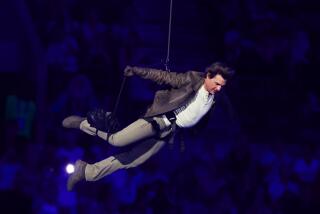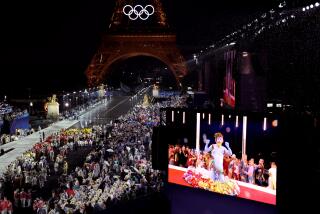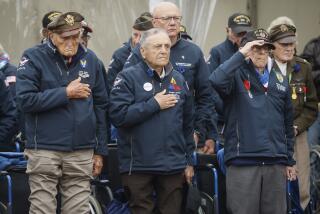A look inside the WWII surrender ceremony: ‘My job was to make sure we did not screw up’
Reporting from Stone Mountain, Ga. — James L. Starnes, navigator of the battleship Missouri, was 24 years old when he learned he would play a key role in the ceremony to mark the end of World War II.
After the Japanese conceded defeat, President Truman announced that “Mighty Mo,” the behemoth 58,000-ton flagship of the 3rd Fleet, would host the signatories of the instrument of surrender in Tokyo Bay.
“My job was to make sure we did not screw up,” said Starnes, 94, who performed the role of officer of the deck the morning of Sept. 2, 1945.
A former lieutenant commander in the Navy who now lives in a retirement community in Stone Mountain, east of Atlanta, Starnes is one of the few remaining veterans who organized the ceremony on the Missouri 70 years ago.
Five years after joining the Navy Reserve’s officer-training program as a student at Emory University in Atlanta in 1940, Starnes was responsible for working out the logistics of the ceremony to mark the formal end of the six-year war that had killed more than 60 million people.
At first he prepared for an elaborate, formal affair with ceremonial dress and gleaming sabers. “We thought, well, this has never happened before,” he said. “We’ll have a big celebration, put on the white uniforms and polish up our swords.”
Before the ceremony, however, Starnes got word that Gen. Douglas MacArthur, commander of the U.S. Army in the Pacific, wanted officers to wear their daily service clothes — khaki button-up shirts with open collars and no ties. “We fought them in our khaki uniforms, and we’ll accept their surrender in our khaki uniforms,” MacArthur was reported to have said.
In the run-up to the big day, Starnes’ main responsibility was working with the ship’s captain, Stuart “Sunshine” Murray, and the admiral’s staff on getting all the various parties — the Allies and the Japanese, as well as nearly 200 correspondents and photographers from all over the world — on and off the battleship.
Starnes likened the job to conducting a symphony orchestra. The timing had to be precise, so there was a lot of fine-tuning: MacArthur made it plain he didn’t want Japanese dignitaries on the Missouri’s deck more than five seconds before 9 a.m., but he also didn’t want them to arrive late.
Rehearsals were staged again and again to work out how long it would take members of the Japanese delegation to disembark from their small boat, come up the gangway, cross the quarterdeck and then reach the surrender deck.
NEWSLETTER: Get the day’s top headlines from Times Editor Davan Maharaj >>
Of particular concern was the Japanese foreign minister, Mamoru Shigemitsu, who had an artificial leg — his right leg had been blown off by a Korean independence activist in Shanghai several years before. Young sailors with swab handles strapped to their legs stood in for Shigemitsu in practice to make sure that the ceremony would be able to accommodate him.
On the morning of Sept. 2, clouds loomed over Tokyo Bay and the mood aboard the gray battleship was somber as the U.S. Marine band played “The Star-Spangled Banner.”
Just before 9 a.m. as planned, Starnes — dressed in pressed khakis, with a pair of binoculars around his neck — waited to meet the Japanese delegation, including Gen. Yoshijiro Umezu, chief of the Imperial Japanese Army General Staff.
Once reaching the deck, the Japanese had to walk past eight seamen, each one more than 6 feet tall. Starnes had picked them out in a calculated effort to emphasize Allied superiority and intimidate the Japanese delegation.
When the Japanese — some wearing tails and top hats — saluted and asked for permission to come aboard, Starnes said, “Permission granted.”
There was no anger or hostility, Starnes said. “This was peacetime,” he said. “It was a very formal, very dignified ceremony.”
Just before proceedings got underway and the surrender documents were brought onto the battleship, it became clear that the elegant mahogany table, a present from the British fleet, was too small to hold both documents during the signing.
With only minutes to go, a humble folding table was grabbed from the crew’s mess, where cooks had just finished cleaning up after breakfast. Hurriedly, Capt. Murray grabbed a green tablecloth, stained with coffee spots, to drape on top.
Thousands of men, from the military’s top brass to regular crewmen, watched as officials signed the documents formalizing the surrender of the Empire of Japan; the Allied copy was bound in leather, the Japanese copy in canvas.
There were a few hitches — the Canadian representative signed on the wrong line — yet for the most part the 23-minute ceremony, broadcast around the world, ran smoothly.
“Let us pray that peace be now restored to the world, and that God will preserve it always,” MacArthur told the assembled crowd. “These proceedings are closed.”
MacArthur then turned to Adm. William F. “Bull” Halsey. “Where are the damn planes?” he asked, referring to the plan to have 450 carrier planes from the 3rd Fleet, followed by B-29 bombers, fly in formation above the battleship.
Suddenly, as the Japanese were escorted off the deck, a swarm of U.S. aircraft roared overhead. “They were so low they made the sky black,” Starnes said.
When it was all over, Starnes said, he felt tremendously elated. “I’d gotten through all of it — I had a lot of friends who died — and here it was all over.”
Yet throughout, Starnes remained stoic, carrying out his business. “I was on duty,” Starnes said. “I wasn’t in a position to jump up and celebrate. I had to write the log after the ceremony.”
After the war, Starnes enrolled in Emory University’s Lamar School of Law and went on to have a successful career in real estate and banking. A decade ago, he traveled to Pearl Harbor to celebrate the 60th anniversary of V-J Day aboard the Missouri, and last year he published a short book, “Surrender: September 2, 1945,” chronicling his wartime experience.
“A lot of people have looked at me as a hero,” Starnes said. “I wasn’t a hero. I was just a participant who happened to be in a particular spot at a particular time.”
Jarvie is a special correspondent.
ALSO:
China is rattling nerves as it prepares to strut its military might
Communists’ version of China’s wartime record frustrates Taiwan
More to Read
Sign up for Essential California
The most important California stories and recommendations in your inbox every morning.
You may occasionally receive promotional content from the Los Angeles Times.











